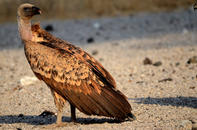
Name
White-backed vulture (Gyps africanus)Appearance
The white-backed vulture is a medium-sized vulture, standing around 95 cm tall and weighing around 4 to 7 kgs. It has a brown to cream plumage with dark tail feathers. The back is off white, but this is only visible in flight. They have a shiny black bill. The head is brown with a white ruff around the neck. The wingspan is around 2 m. Juveniles are largely dark in colour.White-backed Vulture Diet
White-backed vultures are principally carrion eaters.White-backed Vulture Breeding
White-backed vultures are colonial nesters, meaning they nest very close to other white-backed vultures. They nest in trees, using sticks and branches to build a large platform like nest and lay a single egg.White-backed Vulture Behaviour
White-backed vultures are aggressive feeders and will push other animals, that are smaller than itself, away from a carcass. It takes on an aggressive display with outstretched wings and neck to scare the other animals.Threats
The white-backed vulture has been classified as critically endangered in South Africa. This is due to a number of reasons, including the dwindling of habitat, collisions with power lines and nest disturbance. The destruction of trees that are used for nesting is also a factor.
Another threat to the white-backed vulture is poisoning, from eating the carcasses of predators poisoned by farmers or poachers. There is an increase in the use of some pesticides, which has filtered through the food chain and is now leading to the poisoning of the vultures.
Distribution and Habitat
The white-backed vulture is the most common vulture found in game reserves in the Lowveld area. They are found in savannah woodland and bushveld, in the northern area of South Africa. The white-backed vulture is found across most of sub-Saharan Africa.